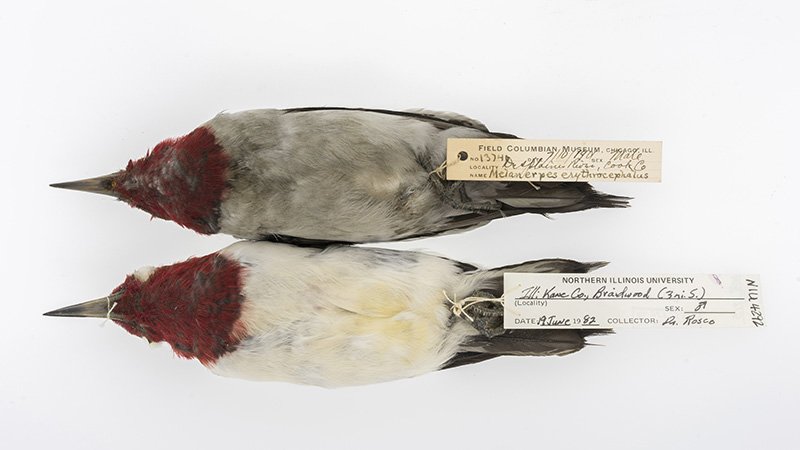
A New Method in Environmental History
As the rate of planetary change accelerates, a study by Carl Fuldner and Shane DuBay demonstrates how time-series provide an indispensable window onto life in the Anthropocene.
Over several months in 2014–15, Shane DuBay (PhD candidate, Evolutionary Biology, UChicago) and Carl Fuldner (PhD candidate, Art History, UChicago) photographed complete sets of select bird species in the Field Museum’s extensive study collections, which include specimens spread over the last 130 years. They titled their project The Phoenix Index. Based on these photographs, they devised a novel means of tracking industrial pollution in the Great Lakes region, which involved analyzing luminance data from within the images to gauge the relative amount of soot covering each bird. The result was a dynamic visual archive that leverages photography to explore the value of "time-series" (a series of values of a quantity obtained at successive times, often with equal intervals between them) for contemporary scientific inquiry. Their analysis provides insights that extend back decades before coordinated systems for measuring air quality, while also restoring the severed link between natural history specimens and the environments from which they were gathered. As the rate of planetary change accelerates, The Phoenix Index demonstrates how time-series provide an indispensable window onto life in the Anthropocene. Read the ASCI Profile Feature on Shane & Carl (2015).
Since their initial work on this project as Graduate Collaboration grantees, DuBay and Fuldner have expanded their study to include bird specimens collected by the University of Michigan Museum of Zoology in Ann Arbor and the Carnegie Museum of Natural History in Pittsburgh. It was important that all three collections were close to industrial centers (Chicago, Detroit, Pittsburgh), and also that they were all more or less evenly spaced throughout the region, giving an excellent geographic cover of the Manufacturing Belt, or the Rust Belt. They have also spent the last two years reshooting every specimen they worked with at the Field Museum the first time around after finding a critical flaw in their lighting method. They did extensive research into lighting and methods of measuring reflectance and worked with several imaging professionals and computer programmers to refine their method. They consulted with UChicago graduate students in Statistics to troubleshoot the issues with their specific dataset to arrive at an approach that would be rigorous in the eyes of a statistician. And, when they ultimately arrived at the analysis and interpretation stage, they realized that they were writing what could be classified as an atmospheric science paper, meaning they had to become conversant in a discipline that falls fully outside both of their native areas of expertise. They sought out several atmospheric scientists at UChicago for guidance. On learning the new scientific terminology, Fuldner and DuBay reported, it "was a steep learning curve for us (we're still learning...), but it really highlights the unexpected interdisciplinary directions that the project has taken as it has developed."
Their findings were recently published in a paper by the Proceedings of the National Academy of Sciences, and the study was covered by media outlets throughout the U.S and abroad.
Carl Fuldner is a PhD candidate in Art History and currently the Marcia Brady Tucker Fellow in the Department of Photography at the Yale University Art Gallery. His dissertation is titled "Evolving Photography: Naturalism, Art, and Experience, 1889–1909" and explores the mutually informing relationship between nature and photography in the late nineteenth century, with an emphasis on Darwinian ideas.
Shane DuBay is a PhD candidate in Evolutionary Biology and is a student of the Bird Division at The Field Museum of Natural History. He studies how interactions between organisms and their environment affect biodiversity
PUBLISHED PAPERS
DuBay, S. and Fuldner, C. "Birds track 135 years of atmospheric black carbon and environmental policy," Proceedings of the National Academy of Sciences of the United States. September 1, 2017.
IN THE NEWS
Their study has attracted a wide range of coverage from popular news outlets:
"Evidence Of Cleaner Air, Hidden In The Drawers Of A Museum," October 13, 2017 - Science Friday
"What Soot-Coated Birds Can Tell Us About the History of Air Pollution—and Its Future," October 13, 2017 - Chicago Magazine
"Soot-Covered Bird Corpses Cough Up Environmental Secrets," October 13, 2017 - The Atlantic
Interview with Carl Fuldner, October 11, 2017 - BBC World News
"A poluição do passado está escrita nos pássaros," October 11, 2017 - El Pais
"What Dead Birds Tell Us about Climate Change," October 11, 2017 - The Scientific American
"The Dirty Secrets Saved in Dead Birds’ Feathers," October 10, 2017 - The New York Times
"Sooty birds' reveal hidden US air pollution," October 10, 2017 - BBC News
"Sooty Feathers Tell the History of Pollution in American Cities," October 10, 2017 - Audubon Magazine
"These dirty birds show why we need natural history museums," October 10, 2017 - Popular Science
"Dirty birds show just how catastrophic air pollution used to be," October 9, 2017 - The Washington Post
"Dirty Birds Are Refinding Climate Models," October 9, 2017 - Discover





All photos by Carl Fuldner
